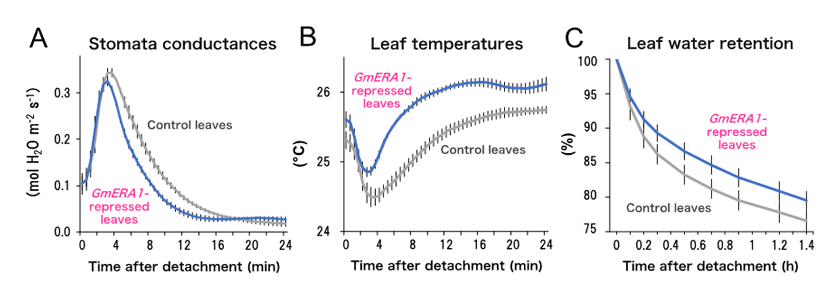Enhancement of drought tolerance in soybean plants by down-regulation of GmERA1 genes
Description
Drought is one of the biggest issues affecting global soybean production. A lot of drought tolerance-related genes have been identified in model plants such as Arabidopsis thaliana. Functional validation of candidate genes could provide gene resources for breeding varieties of non-model staple crops, such as soybean, that can withstand drought conditions. Previous research has implicated that farnesyltransferase gene ERA1 in A. thaliana is one of promising candidates for genetic manipulation of drought stress tolerance. Although ERA1 homologs in soybean plants (GmERA1) could be a candidate for improving drought tolerance, the function of GmERA1 had been unrevealed. As soybean is recalcitrant to transformation and gene expression analysis, we employed a virus vector system to validate the potential candidate gene GmERA1 for drought resistance in soybean.
A plant virus vector derived from Apple latent spherical virus (ALSV) was used for the functional analysis of GmERA1 in soybean plants. Soybean leaves subjected to ALSV-mediated GmERA1-down-regulation showed increased drought stress responses with reduced water loss, gas exchanges and higher leaf surface temperature (Fig. 1). GmERA1-down-regulated soybean plants also showed reduced wilting and higher survival rate under water-limiting conditions compared to control plants (Fig. 2).
Our data support the proposal that GmERA1 can be downregulated to increase drought tolerance in soybean. We also demonstrate that the virus vector system, which bypasses the need to generate transgenic plants, is a useful tool for evaluating candidate drought-resistance genes in soybean in the short term.
Figure, table
-
Fig. 1. Improved drought stress responses in GmERA1-repressed soybean leaves
Leaf detachment-induced response of stomatal conductance (A), leaf temperature (B), and water retention (C) in soybean leaves infected with GmERA1-recombinant virus were measured. Data are means ± SE (n = 3 to 6). Figures are modified from Ogata et al. (2017). -
Fig. 2. Improved drought tolerance in GmERA1-repressed soybean plants
The soybean plants infected with GmERA1-recombinant virus were withheld water for three days before re-watering (left panels). Survival rate of the plants were recorded after re-watering (right panel). Data are means ± SE (n = 3 to 6). Figures are modified from Ogata et al. (2017).
- Affiliation
-
Japan International Research Center for Agricultural Sciences Biological Resources and Post-harvest Division
- Research project
- Program name
- Term of research
-
FY2017(2016~2020)
- Responsible researcher
-
Ogata Takuya ( Biological Resources and Post-harvest Division )
Nagatoshi Yukari ( Biological Resources and Post-harvest Division )
Fujita Yasunari ( Biological Resources and Post-harvest Division )
Yamagishi Noriko ( Faculty of Agriculture, Iwate University )
Yoshikawa Nobuyuki ( Faculty of Agriculture, Iwate University )
KAKEN Researcher No.: 40191556 - ほか
- Publication, etc.
-
https://doi.org/10.1371/journal.pone.0175650
Ogata T et al. (2017) PLOS ONE, 12(4): e0175650
- Japanese PDF
-
A4 416.92 KB
A3 324.2 KB
- English PDF
-
A4 199.35 KB
A3 192.89 KB
- Poster PDF
-
2017_B08_poster.pdf507.18 KB


